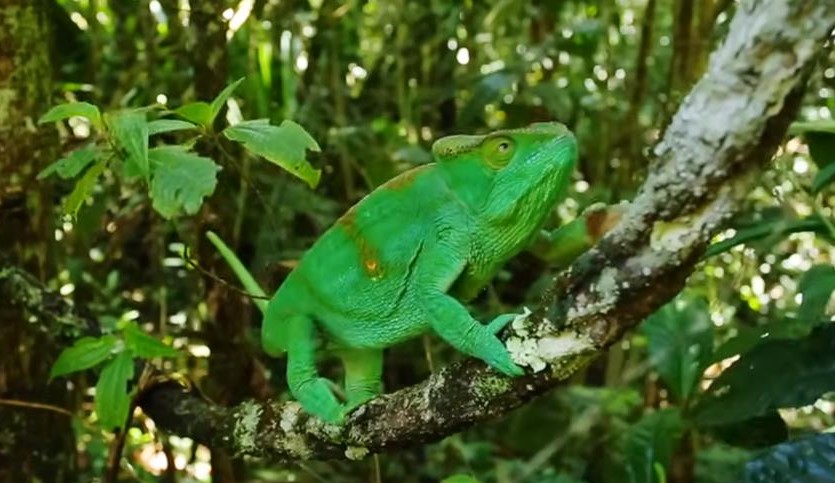Good plants for chameleon cages include Ficus, Hibiscus, Pothos, and Dracaena. These plants provide coverage and climbing opportunities.
Selecting the right foliage for a chameleon cage not only enhances the visual appeal but also promotes a healthy habitat for your pet. Chameleons thrive in environments where they can blend in and feel secure, so adding live plants mimics their natural ecosystem.
The lush greenery of a Ficus or Pothos provides excellent hiding spots, which is essential for reducing stress in chameleons. With vibrant flowers, a Hibiscus can offer a touch of color while also serving as a potential snack. Dracaena plants add vertical interest and an extra climbing surface, perfect for an arboreal species like the chameleon. Incorporating these plant choices supports the well-being of your chameleon while making maintenance convenient for the owner.
Ideal Habitat For Chameleons
Creating the ideal habitat for chameleons is crucial for their health and happiness. These colorful reptiles thrive in environments that mimic their natural habitat. A well-designed cage with the right plants offers safety and comfort for your chameleon, letting it feel at home. Let’s explore what makes the perfect chameleon cage set-up.
Natural Environment Simulation
Chameleons come from a range of environments, from rainforests to deserts. Despite these differences, all chameleons need certain elements in their cages. Their habitat should have branches for climbing and leaves for hiding. This arrangement mimics the complexity of a natural landscape.
- Plenty of climbing space is important for exercise.
- Shaded areas provide a place to escape the light.
Consider these factors to replicate the diverse layers and textures found in the wild:
- Use live plants when possible for the best humid environment.
- Choose species that can hold up to a chameleon’s weight.
Importance Of Foliage
The right foliage creates a lush, leafy environment. It gives your chameleon places to hide and hunt insects. Plants also maintain humidity and clean the air, which benefits your pet. Ensure the plants are non-toxic and safe for chameleons. Here’s a list of suitable plants:
| Plant Type | Benefits |
|---|---|
| Ficus | Sturdy branches for climbing |
| Pothos | Dense foliage for hiding |
| Dracaena | Tall with leaves for perching |
| Hibiscus | Flowers and leaves for snacking |
Pick plants that suit the size and activity level of your chameleon. Remember to keep the soil-covered to prevent accidental ingestion.
Selecting The Right Plants
Creating a home for your chameleon is exciting! But it’s more than fun. It’s about making sure your little buddy stays safe and happy. One big part of that? The plants in their cage. Let’s dive into how to pick the best ones.
Criteria For Plant Choice
Chameleons love climbing and hiding. So, it’s crucial to choose plants that can support their lifestyle. Here’s what to look for:
- Durable leaves that can hold a chameleon’s weight.
- Non-toxic species to keep your friend safe.
- Bright light needs, just like chameleons.
- Similar humidity requirements to chameleon habitats.
Safety Considerations
Safety first! Not all plants are chameleon-friendly. Here’s how to keep it safe:
| Feature | Details |
|---|---|
| Toxicity | Avoid plants that are poisonous to chameleons. |
| Pesticides | Choose plants free from harsh chemicals. |
| Spines & Thorns | Stay away from plants that can scratch or poke. |
| Easy to Clean | Select plants that are simple to maintain and keep tidy. |
Top Plant Choices For Chameleon Cages
Creating a natural habitat for your chameleon is crucial. Choosing the right plants for their cages makes a big difference. Not only do plants provide your chameleon with a more comfortable and realistic environment, but they also offer essential hiding spots and climbing areas.
Let’s dive into some of the best plant options for your chameleon’s cage.
Ficus
The Ficus plant, also known as the weeping fig, is a popular choice. Its hardy leaves and sturdy branches can support a chameleon’s weight. It thrives in the same humid conditions that chameleons love.
- Benefits: Strong branches, easy to find
- Care Level: Moderate
- Humidity: High
Hibiscus
Hibiscus plants add a splash of color to your chameleon’s home. They are safe for chameleons and can even provide a tasty snack. The wide leaves offer plenty of shade and shelter.
| Benefits | Care Level | Humidity |
|---|---|---|
| Bright flowers, edible | Moderate | Medium to High |
Pothos
For a low-maintenance option, Pothos is perfect. It’s fast-growing and can create a jungle-like feel quickly. Pothos can tolerate various lighting conditions, making it versatile.
- Benefits: Easy to grow, purifies air
- Care Level: Easy
- Humidity: Tolerant
These plants not only make the cage look amazing but also keep your chameleon healthy. Remember to check the safety of each plant beforehand and ensure they are free of pesticides.
The Benefits Of Each Plant
Chameleons thrive in an environment that mimics their natural habitat. The right plants can transform a cage into a lush and comfortable home. Let’s explore the perks of different plants for a chameleon enclosure and the unique advantages each brings to your pet’s life.
Leaf Density And Coverage
Plants with ample foliage provide shelter and privacy for chameleons. They create a naturalistic setup that encourages normal behavior. The leaf coverage also offers a safe place for chameleons to hide and rest, reducing stress. Here are some optimal plants for leaf density and coverage:
- Ficus trees: Dense leaves, perfect for hiding.
- Schefflera: Offers substantial coverage.
- Pothos: Spreads quickly, creating a green canopy.
Edible Options
Some plants not only provide shelter but are also safe for chameleons to nibble on. These edible options can supplement their diet and offer a source of hydration. Important edible plants to consider include:
- Hibiscus: Both flowers and leaves are edible.
- Dandelion: Nutritious leaves, easy to grow.
- Mulberry leaves: A rare treat, high in vitamins.
Maintenance And Care
Easy-care plants ensure the habitat remains healthy without added stress. Select plants that have similar light and water needs to your chameleon’s requirements. Here’s a quick guide for low-maintenance plants:
| Plant | Water Needs | Light Needs |
|---|---|---|
| Spider plants | Moderate | Low to medium |
| Dracaenas | Low to moderate | Medium |
| ZZ plants | Low | Low |
These plants are durable and tolerate various conditions, making them great for chameleon cages.
Creating A Healthy Living Space
Welcome to the vibrant world of chameleon care!
Creating a healthy living space for chameleons means mimicking their natural habitat.
This environment encourages their well-being and showcases their unique behaviors.
Layout Design
Designing the right layout is crucial for a chameleon’s home.
An ideal setup includes varying branches and foliage for climbing.
Arrange plants to offer ample space for movement.
Choose safe, non-toxic plants that thrive in similar conditions.
- Ficus for sturdy climbing
- Pothos for lush coverage
- Dracaena for height variation
These create natural hiding spots and climbing areas.
Balancing Humidity And Light
Balance between humidity and light supports health and vibrant coloration.
Use plants that maintain stable humidity levels.
- Boston ferns for moisture
- Bromeliads for water reservoirs
Ensure proper lighting for plant and chameleon health.
UVB lights support chameleon’s skeletal health and plant growth.
Place lights above plants to mimic natural sunlight.
Regularly check humidity with a hygrometer to adjust as needed.
Long-term Plant Care In Chameleon Habitats
Long-term Plant Care in Chameleon Habitats is essential for maintaining a healthy and visually appealing environment for your pet chameleon. Plants in chameleon cages provide not only aesthetic value but also serve as an important part of the ecosystem, offering hiding spots and climbing areas for these colorful reptiles. Consistent maintenance ensures that plants remain safe and beneficial for the habitat.
Pruning And Trimming
Pruning and trimming are vital to manage plant growth inside chameleon cages. Overgrown plants can obstruct light and airflow, which are critical for your chameleon’s health. Regular pruning helps to:
- Maintain plant size and shape
- Encourage new growth, fostering a lush environment
- Remove dead or dying foliage to prevent the spread of disease
Monitoring Plant Health
Keeping an eye on plant health is essential. Look for signs such as:
| Signs of Healthy Plants | Signs of Unhealthy Plants |
|---|---|
| Bright, vibrant leaves | Wilting or yellowing leaves |
| Sturdy stems | Weak, rotting stems |
| Fresh smell | Foul odor |
Address any issues promptly to prevent them from escalating and affecting your chameleon.
Replacing Plants When Necessary
Sometimes, despite your best efforts, a plant may not recover. Be prepared to replace plants when necessary. This maintains the habitat’s health and appeal. Consider keeping a few extra plants on hand to make replacements easy and stress-free for you and your pet.
Frequently Asked Questions On What Plants Are Good For Chameleon Cages?
Which Plants Are Safe For Chameleons?
Safe plants for chameleons include Ficus benjamina, Schefflera arboricola, and Hibiscus rosa-sinensis. Always ensure the plants are non-toxic and pesticide-free for the chameleon’s safety.
What Are The Best Live Plants For Chameleon Habitats?
The best live plants for chameleon habitats are pothos, dracaena, and bromeliads. They thrive in similar humidity conditions and provide natural shelter.
How Do I Choose Plants For My Chameleon Cage?
Select plants that can tolerate high humidity and provide ample cover. They should be sturdy enough to support a chameleon’s weight and safe if ingested.
Can Chameleons Benefit From Having Live Plants?
Yes, live plants benefit chameleons by increasing humidity, offering hiding spots, and allowing natural leaf-eating behavior, promoting overall well-being.
Conclusion
Selecting the right plants for your chameleon’s environment is crucial for their health and happiness. Foliage like pothos, hibiscus, and ficus provide not only a natural habitat but also vital enrichment. By choosing non-toxic, sturdy, and appropriate plants, you create a thriving space for your pet chameleon to explore and enjoy.
Remember to ensure the plants are safe, well-maintained, and suitable for your chameleon’s specific needs. Your attentive care will be reflected in the vibrancy and activity of your fascinating reptilian companion.

